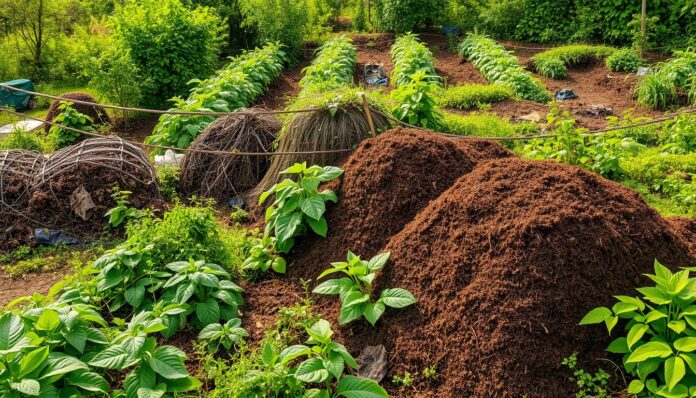What if waste was not a problem, but an opportunity? This is the mindset shift that permaculture promotes. It’s changing how we view waste management. By using permaculture principles, we can cut down on waste and work towards a greener future.
Permaculture waste processing is a complete system for sustainable design. It’s applied to waste management to foster a circular economy. Sustainable waste management is crucial in permaculture. It uses organic waste composting to lessen waste and aim for a sustainable future.
Permaculture waste processing uses permaculture principles to tackle waste and aim for sustainability. It employs organic waste composting, recycling, and reuse to cut down waste. By adopting these principles, we can lessen our waste and strive for a greener future.
Permaculture seeks to establish a closed-loop system. It recycles materials back into the food system whenever possible. This reduces the waste sent to landfills.
Key Takeaways
- Permaculture waste processing is a holistic approach to designing sustainable systems.
- Permaculture principles can be applied to waste management to create a more circular economy.
- Organic waste composting is a key aspect of permaculture waste processing.
- Permaculture aims to create a closed-loop system, recycling materials back into the food system wherever possible.
- Permaculture waste processing involves the use of recycling, reuse, and reduction to minimize waste.
- Permaculture waste processing can help to reduce the amount of waste that is sent to landfills.
- Permaculture waste processing can help to create a more sustainable future.
Understanding Permaculture and Its Principles
Permaculture is a design system that works with nature, not against it. It was started by Bill Mollison and David Holmgren. The core of permaculture is caring for the earth, people, and sharing fairly. These permaculture principles help design sustainable systems, including waste management.
The aim of permaculture is to get more with less effort. It aims to reduce waste management and promote sustainable systems. This is done by observing nature, using renewable resources, and encouraging biodiversity. Learning about permaculture helps us live more sustainably.
- Observing natural cycles to understand when to plant or harvest specific crops
- Utilizing organic resources such as solar, wind, and water power
- Practicing composting and recycling organic waste to minimize waste management
By following permaculture principles and creating sustainable systems, we can lessen our environmental impact. This approach to waste management and sustainability is key to a better world for the future.
Types of Waste in Permaculture Systems
Permaculture systems aim to manage waste for a sustainable future. They handle three main types: organic, inorganic, and hazardous waste. Knowing these types is key to good waste management.
Organic waste, like food scraps and yard trimmings, can be turned into rich soil through composting. Inorganic waste, including plastics and metals, can be recycled or reused. Hazardous waste, like toxic chemicals, needs careful disposal.
Organic Waste
Organic waste breaks down easily and can be composted. It includes:
- Food scraps
- Yard trimmings
- Manure from animals
Inorganic Waste
Inorganic waste doesn’t break down and needs special care. It includes:
- Plastics
- Metal
- Glass
Hazardous Waste
Hazardous waste is dangerous and must be disposed of carefully. It includes:
- Chemicals
- Pesticides
- Batteries
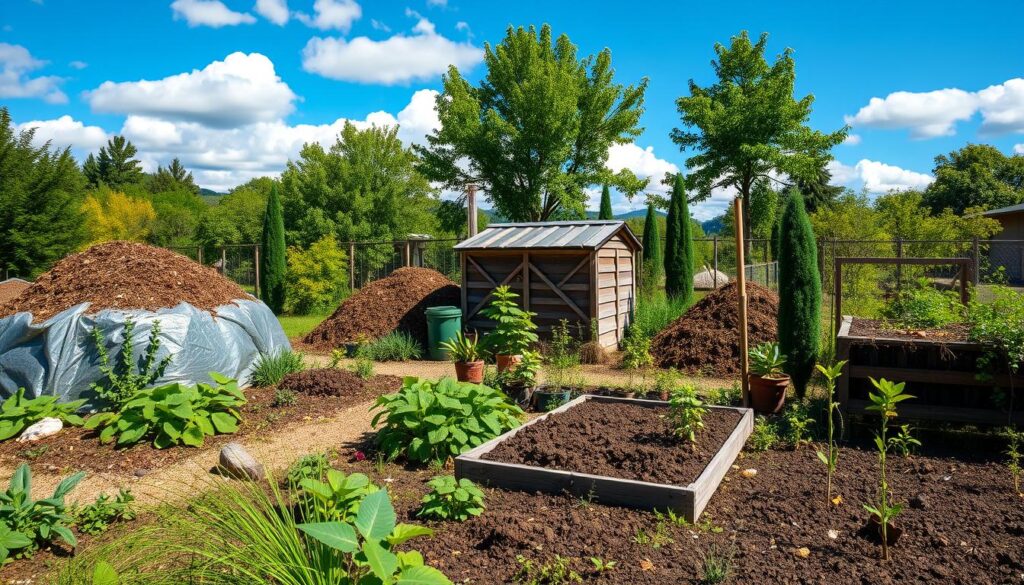
| Type of Waste | Examples | Management |
|---|---|---|
| Organic Waste | Food scraps, yard trimmings | Composting |
| Inorganic Waste | Plastics, metal, glass | Recycling, repurposing |
| Hazardous Waste | Chemicals, pesticides, batteries | Special handling and disposal |
Benefits of Waste Processing in Permaculture
Waste processing is key in permaculture. It cuts down on environmental harm, boosts soil health, and supports biodiversity. By using smart waste management, we can lessen our impact on the planet and make our surroundings greener.
Some major perks of waste processing in permaculture are:
- Less waste ends up in landfills, which means fewer greenhouse gases and less climate change
- Compost made from waste is full of nutrients, making plants grow better and soil healthier
- It also saves water and cuts down on the need for harmful chemicals and pesticides
Waste processing in permaculture also helps biodiversity. It creates homes for good bugs and microbes. This is done through composting, like vermicomposting, which uses worms to break down waste.
| Waste Management Strategy | Environmental Benefits |
|---|---|
| Composting | Reduces greenhouse gas emissions, conserves water, and creates nutrient-rich soil |
| Vermicomposting | Promotes biodiversity, reduces waste sent to landfills, and creates a natural fertilizer |
By choosing these waste management methods, we can live more sustainably. We reduce our harm to the environment and help our soil and biodiversity thrive.
Composting as a Waste Processing Method
Composting is a key part of permaculture, turning waste into something useful. It uses tiny organisms to break down organic materials. This creates compost that makes soil healthier and more fertile.
The quality of compost depends on a few things. These include the mix of carbon and nitrogen, how wet it is, and if it has enough air. A good mix of carbon and nitrogen is between 25:1 and 30:1. Keeping the right moisture and air is also key for it to work well.
Setting up a composting system needs careful planning. You need to pick the right bin, like a three-bay or tumbler bin. You should add materials like leaves, shredded paper, and kitchen scraps. But, avoid adding meat, dairy, or pet waste as they can attract pests and smell bad.
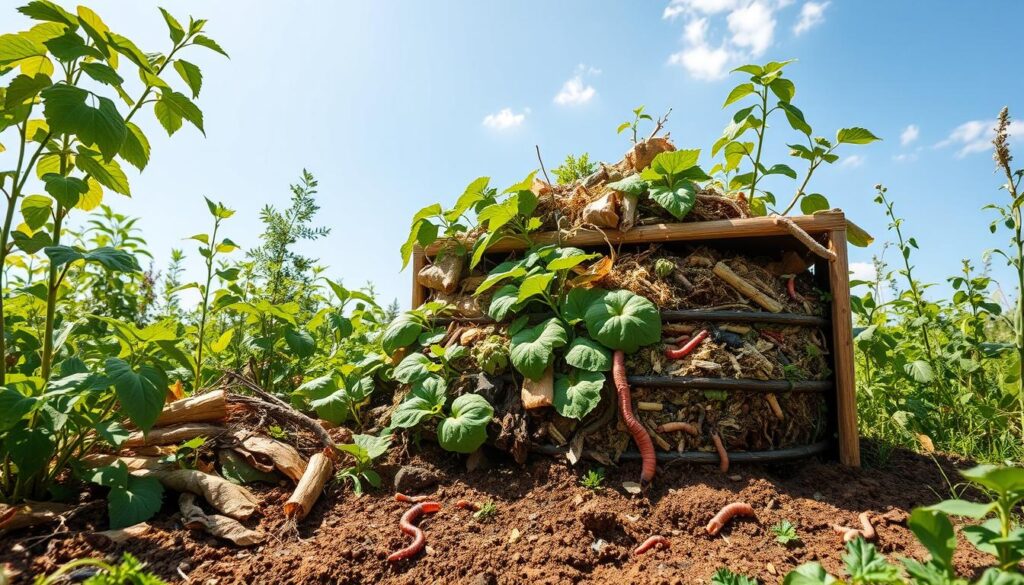
A good composting system can make high-quality compost in just 3 months. This can help reduce waste and save money on trash and garden supplies. By composting, people can help the environment and support sustainable living.
| Composting Factor | Recommended Level |
|---|---|
| Carbon-to-Nitrogen Ratio | 25:1 to 30:1 |
| Moisture Content | 40-60% |
| Compost Pile Temperature | 100-140°F |
Vermicomposting for Effective Waste Management
Vermicomposting uses worms to break down organic waste. It’s a natural and eco-friendly way to manage waste. It’s perfect for small spaces and requires little effort, making it great for those who want to help the environment.
Using vermicomposting helps create a sustainable future and cuts down on landfill waste. You set up a worm bin and add worms. They turn the waste into a compost that’s full of nutrients. This compost can then be used to feed plants, reducing the need for harmful fertilizers.
Benefits of Vermicomposting
Vermicomposting is cost-effective, needs little space, and provides a steady supply of compost. The worms, like red wigglers, grow fast. They can double in number every two months if conditions are right. This makes vermicomposting a sustainable and efficient way to manage waste.
Setting Up a Worm Bin
To start a worm bin, you need the right worms, like red wigglers. You also need to create a good environment for them. Worms prefer temperatures between 13°C (55°F) and 25°C (77°F). They also need a mix of 70% green matter and 30% brown waste. With the right care, a worm bin can keep giving you compost, which is very valuable for waste management.
Using Bokashi for Kitchen Waste
Bokashi is a way to compost kitchen waste without needing much space. It uses special microbes to break down waste, making it into a nutrient-rich compost. This method is great for small homes because it works indoors and doesn’t take up much room.
Benefits of Bokashi Composting
The advantages of bokashi composting are:
- Less waste ends up in landfills
- You get compost that’s good for your garden
- It doesn’t smell bad or attract pests
- It’s perfect for small spaces and can be done indoors
Implementation Process
To start bokashi composting, follow these steps:
- Put kitchen waste in a special bin
- Put bokashi bran on the waste
- Let it ferment for about two weeks
- Move the fermented mix to a compost pile or garden bed
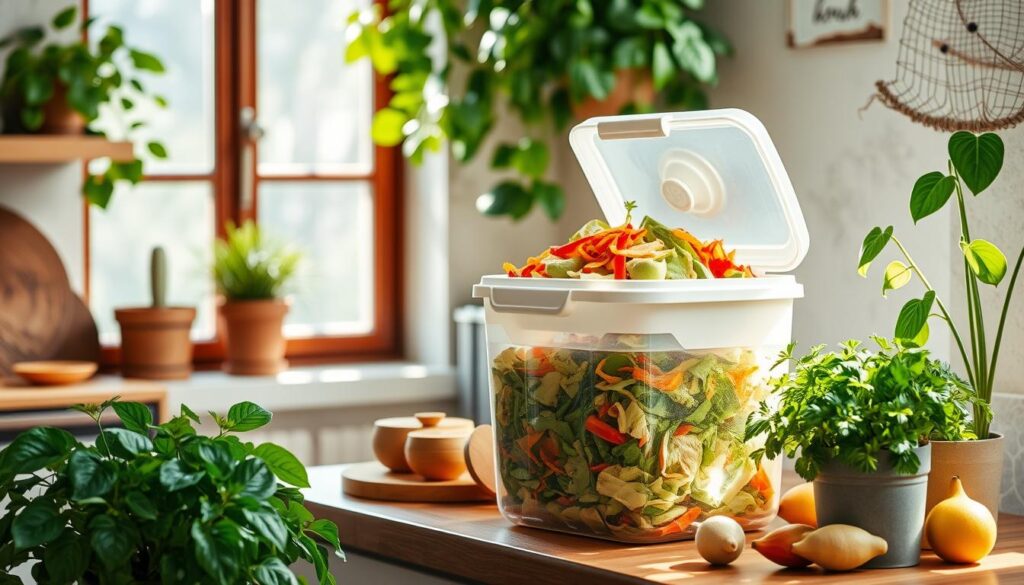
Using bokashi for kitchen waste helps the environment and supports gardening. It’s a simple way to manage waste and make compost. This method reduces landfill waste and helps your garden grow.
Biogas Production in Permaculture
Biogas production is a key part of waste management in permaculture. It involves breaking down organic waste to make biogas. Biogas systems are used to make this process more efficient. A biogas digestor is a key part of these systems, needing careful planning to produce good biogas.
Biogas has many benefits in permaculture. It produces renewable energy, reduces waste, and improves soil health. Biogas systems can be made for any size, from small for homes to big for businesses. The best temperature for making biogas is around 95 degrees Fahrenheit, with a short retention time of 15 days. The pH level should be between 6.5 and 7.5 for a healthy digestion process.
When making a biogas digestor, you need to look at the waste available, design the right size, and keep the digestion conditions perfect. The biogas made is mostly methane, a clean energy source. By using biogas systems in permaculture, farms can use less fossil fuel, move towards renewable energy, and lower their carbon footprint.
- Biogas production cuts down on greenhouse gas emissions from animal waste.
- Biogas systems help break down organic matter, making biogas.
- Digestate, the leftover from biogas production, is a rich fertilizer.
To keep biogas systems working well, regular upkeep and skilled operation are key. By knowing about biogas systems and their benefits, permaculture experts can make their systems more sustainable and self-sufficient.
Utilizing Mulching Techniques
Mulching is a key part of permaculture, bringing many benefits to gardens. It helps reduce waste and boosts soil health and crop yields. This is very helpful in places where water is scarce, as it keeps the soil moist.
Mulching offers many advantages, like reduced soil erosion and better soil fertility. Effective organic mulches include wood chips, straw, and leaves. It’s important to pick the right mulch and apply it correctly for the best results.
Some key benefits of mulching are:
- Less need for herbicides and manual weeding
- Better soil structure and drainage
- More nutrients for plants
- More biodiversity and a stronger ecosystem
By using mulching, gardeners can make their gardens more sustainable and efficient. This reduces waste and helps create a healthier environment.
| Mulching Method | Recommended Thickness | Benefits |
|---|---|---|
| Sheet Mulching | 3-4 inches | Reduced weed growth, improved soil moisture |
| Deep Mulching | 6-8 inches | Improved soil fertility, increased biodiversity |
Capturing Rainwater for Resource Efficiency
Rainwater harvesting is a smart way to collect and store rainwater for various uses. It helps reduce the need for clean water and lowers waste disposal’s environmental harm. Resource efficiency is a big plus, as it taps into a free and plentiful resource.
There are different ways to collect rainwater, like from rooftops or the ground. These systems can store rainwater for uses like watering plants and flushing toilets. Using rainwater harvesting systems can lower water bills and cut down on reliance on city water.
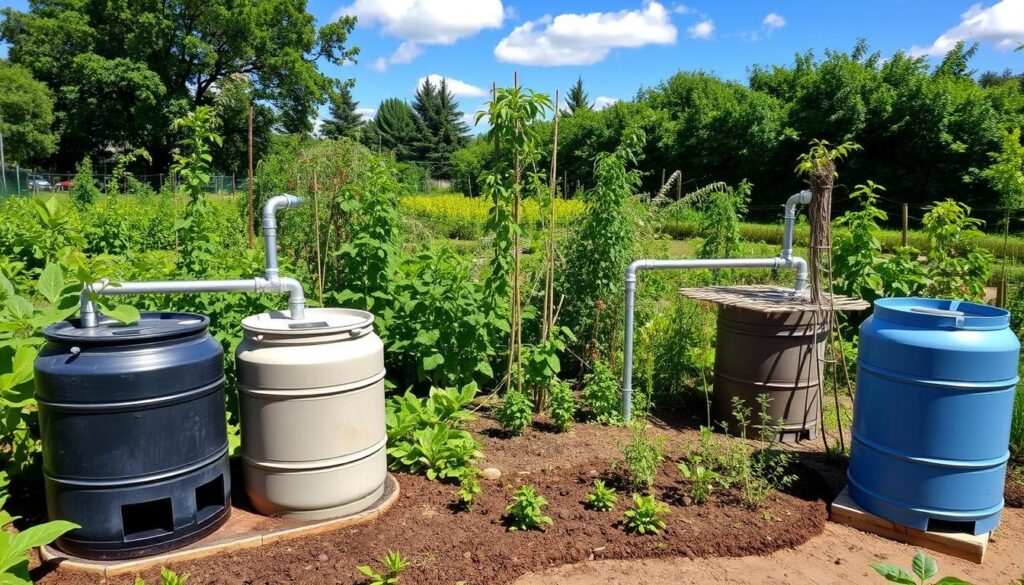
Benefits of rainwater harvesting include:
* Lower water bills
* Less strain on city water supplies
* Less harm to the environment from waste
* More resource efficiency
By setting up rainwater collection systems, people help make water management more sustainable and eco-friendly.
Building Soil with Hugelkultur
Hugelkultur is a method of soil building that’s popular in permaculture. It uses wood debris to make soil rich in nutrients. This method also helps reduce waste by using materials that would be thrown away.
What is Hugelkultur?
Hugelkultur comes from Germany and means “mound culture” or “wood heap culture.” It mimics how forest floors work, where trees and branches break down and make the soil better. This way, people can make very fertile soil that plants love.
Benefits of Hugelkultur Beds
Hugelkultur beds have many good points. They make the soil better, help plants grow more, and need less water. They also help many different living things, which is good for a healthy environment.
How to Create a Hugelkultur System
Setting up a hugelkultur system is easy. First, dig a hole, then fill it with wood. Next, add soil and other organic stuff on top. As the wood breaks down, it makes the soil very fertile. This is a big part of permaculture because it’s about using less and being more sustainable.
Integrated Pest Management (IPM)
Integrated pest management (IPM) is key in permaculture. It helps cut down on chemical pesticides and keeps ecosystems balanced. IPM uses various methods like biological, cultural, and physical controls to manage pests and waste. This approach helps gardeners lower their environmental impact and build a sustainable food system.
Important IPM practices include monitoring plants for pests, using physical barriers to stop pests, and introducing beneficial insects to fight pests. It also means reducing waste by using methods like crop rotation, composting, and mulching. These steps help lessen waste from pest control.
Examples of IPM Techniques
- Crop rotation to break pest cycles
- Biological control using beneficial insects, such as ladybugs and lacewings
- Cultural control through proper watering, pruning, and fertilization
- Physical control using barriers, traps, and hand-picking
Using IPM techniques helps gardeners lessen their chemical pesticide use. This makes ecosystems more balanced. It also promotes integrated pest management and sustainable food production. The EPA of NSW says IPM includes biological, cultural, physical, chemical, plant choice, genetic, and pheromone controls. These methods help manage pests in a more holistic way.
The Role of Fungi in Waste Decomposition
Fungi are key in breaking down organic matter, making soil rich in nutrients. This is vital for keeping ecosystems healthy and diverse.Mushroom cultivation helps use fungi for this purpose. It lets different fungal species efficiently break down waste.
Benefits of Fungal Decomposition
Fungal decomposition offers many benefits. It makes soil rich in nutrients and cleans pollutants from the environment. Fungi can also make complex organic compounds easier for plants to use. Plus, they help improve soil structure, which means better water retention and less erosion.
Mycoremediation Explained
Mycoremediation uses fungi to clean pollutants from the environment. It’s been shown to remove heavy metals and toxins from soil. For example, oyster mushroom mycelia can filter contaminants from agricultural runoff. This shows a positive step towards reducing pollution in farming.
Cultivating Fungi in Permaculture
In permaculture, fungi are used to break down waste and enrich soil. This is done through mushroom cultivation and mycoremediation. Using fungi in this way boosts biodiversity, improves soil health, and lessens environmental harm.
Creating a Zero-Waste Permaculture System
Creating a zero-waste permaculture system means designing ways to cut down on waste and use resources better. It’s based on permaculture’s main values: caring for people, the earth, and sharing fairly. By living zero-waste, people can greatly lessen their harm to the environment. Studies show that up to 80% of what we throw away can be cut down.
Reducing waste is a big part of zero-waste permaculture. We can do this by composting, recycling, and finding new uses for things. For instance, composting can cut waste by 30%. Recycling helps send less to landfills. And finding new uses for old stuff also helps reduce waste.
Getting communities involved is also key. Together, we can share knowledge and work on waste management. This teamwork can make achieving zero-waste goals 40% more likely. It also builds stronger, more efficient communities.
| Strategy | Benefits |
|---|---|
| Composting | Reduces waste by 30% on average |
| Recycling | Decreases waste sent to landfills |
| Reuse | Conserves resources and reduces waste |
By going for a zero-waste permaculture, we can really make a difference. It’s good for the planet and helps us live in a more sustainable, self-sufficient way.
Case Studies in Permaculture Waste Processing
Permaculture waste processing is about designing systems to handle waste without harming the environment. Case studies show how well these systems work. Projects at home, like composting and vermicomposting, have been a big success.
Some case studies highlight the use of biogas systems and hugelkultur for organic waste. These methods cut down waste and help the planet. Permaculture waste processing is key to a greener, more self-sufficient life.
Here are some examples of successful domestic projects:
- Composting and vermicomposting systems for kitchen waste
- Biogas systems for managing organic waste
- Hugelkultur beds for promoting soil health and reducing waste
These case studies prove that permaculture waste processing works. They offer lessons for setting up similar systems elsewhere. By using these methods, we can all help the planet and live more sustainably.
Future Trends in Permaculture Waste Processing
Permaculture systems are getting better, and waste management will see big changes. New composting technology will use artificial intelligence to make composting better. These smart systems will watch over the compost, adjust it, and give tips to gardeners.
We also expect more people to learn about and join in on sustainable waste practices. Programs and groups will teach people how to live without waste. This will help change how we use resources.
Creating strong regulatory frameworks is also key. Leaders and policymakers need to work together to make rules that help reduce waste. This will make it easier to manage waste and move towards a greener future.
As permaculture grows, dealing with waste will be a big part of it. With new tech, community involvement, and good rules, permaculture can turn waste into something useful.

